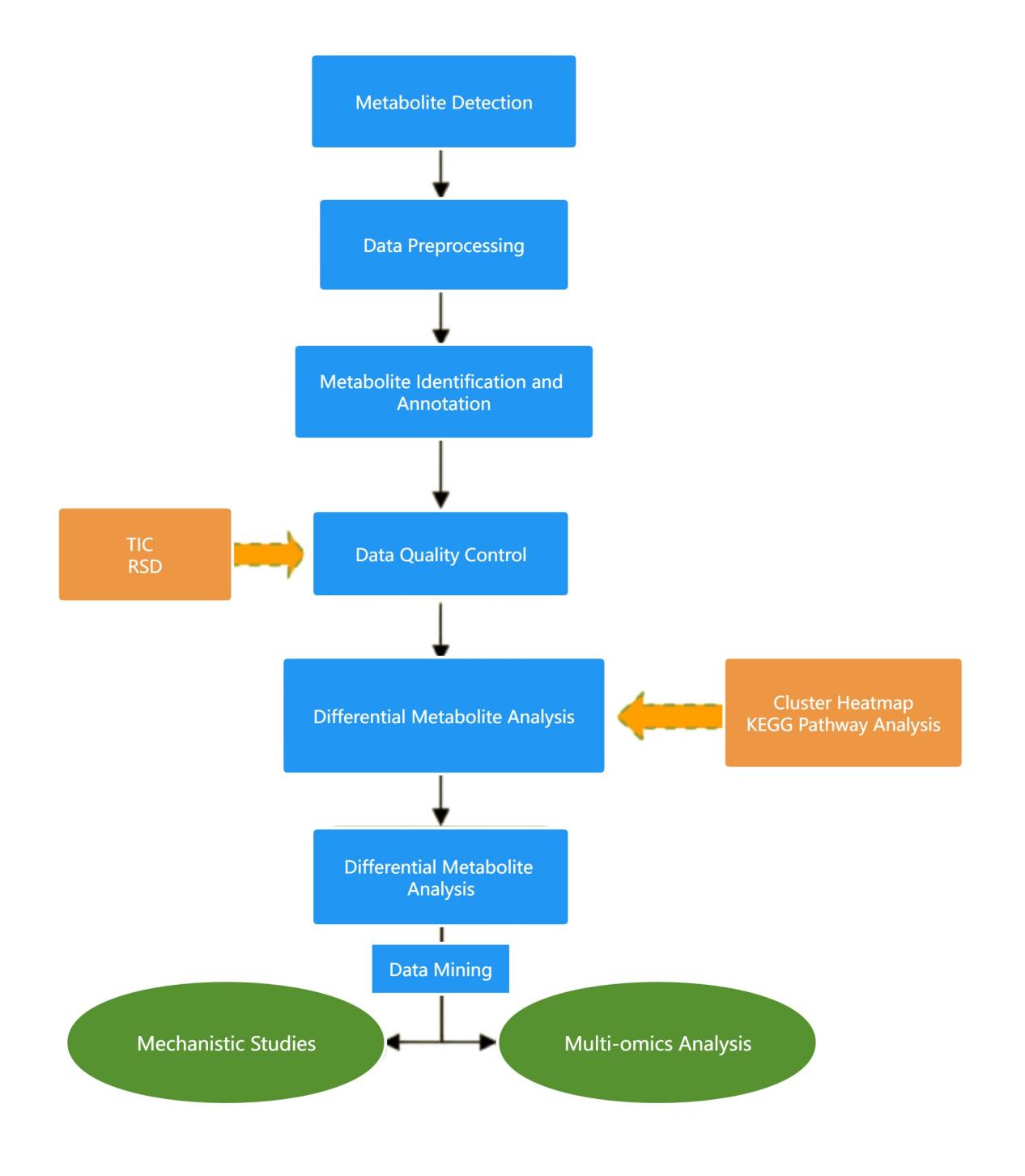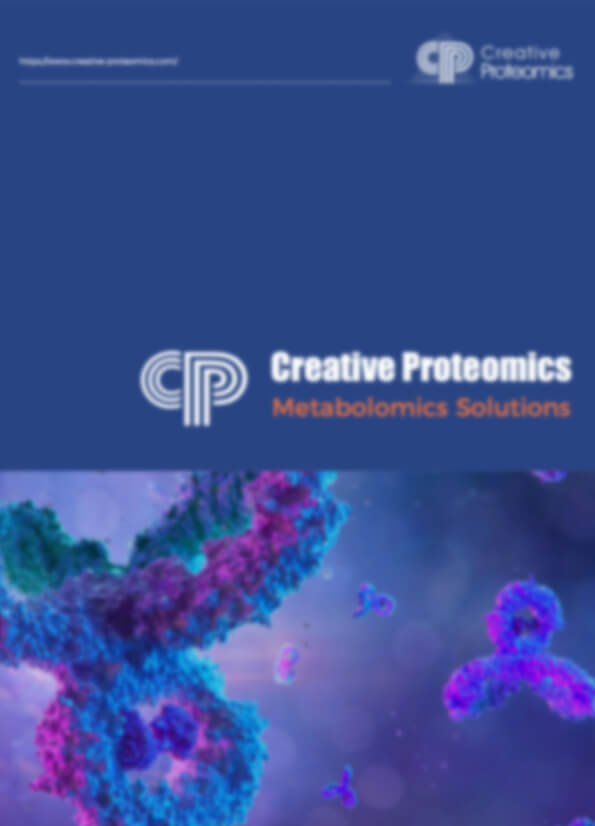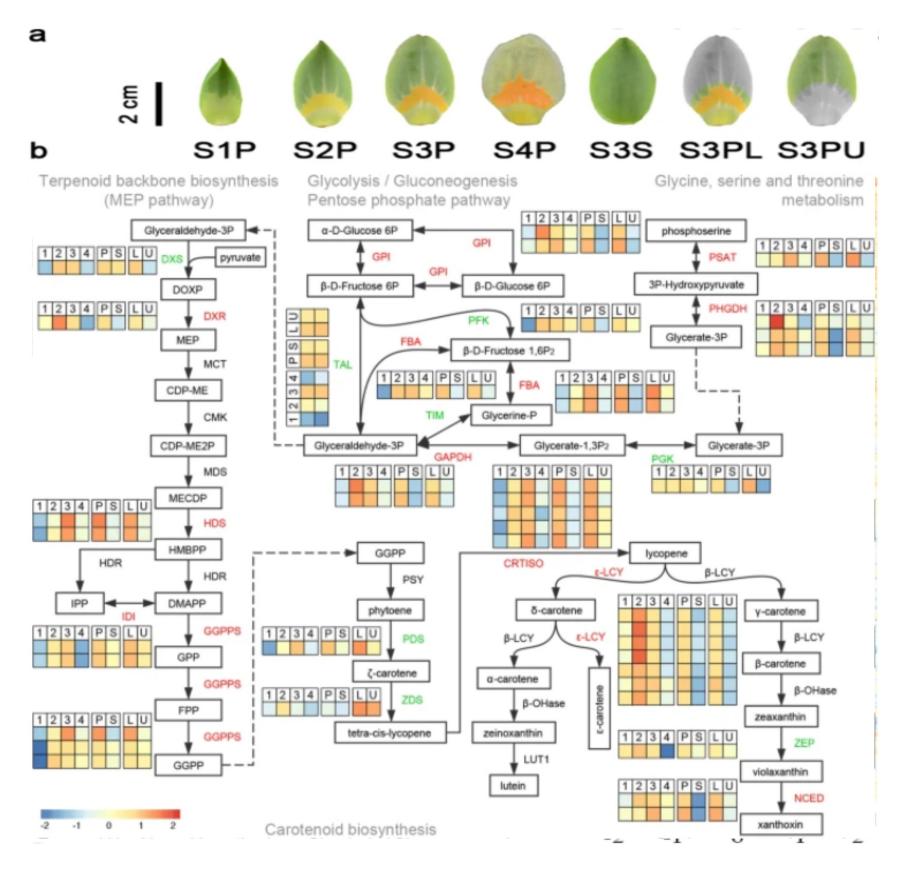Carotenoids Analysis Service
Creative Proteomics offers advanced carotenoid analysis services tailored to diverse research needs. Utilizing cutting-edge techniques such as LC-MS/MS, HPLC-DAD, and HPLC-MS, the company ensures precise detection and quantification of carotenoids, xanthophylls, and carotenoid esters across a wide range of sample types. Services include both standard carotenoid detection and saponified carotenoid detection, with high sensitivity and throughput, enabling applications in plant development, stress response, nutrition, coloration, and trait regulation research. With robust workflows, pre-sales consultation, and post-sales technical support, Creative Proteomics supports scientists in unraveling the intricate roles of carotenoids in biological systems.
Submit Your Request Now
×- Define
- Type
- What We Provide
- Carotenoid Compounds List
- Advantages
- Applications
- Sample Requirements
- Demo
- FAQs
- Case
- Publications
What are Carotenoids?
Carotenoids, found in a wide range of fruits and vegetables, contribute to their vibrant colors, including shades of orange, yellow, and bright red. These pigments are crucial for plant health and serve as auxiliary chloroplast pigments during photosynthesis, safeguarding chlorophyll from damage caused by intense light. Additionally, carotenoids act as precursors for synthesizing abscisic acid (ABA).
Carotenoids belong to the category of phytonutrients and are found within the cells of a broad spectrum of organisms, encompassing bacteria, algae, and plants. Although foods rich in carotenoids are generally recognized by their red, yellow, or orange coloration, exceptions do exist. It is worth highlighting that animals lack the ability to internally synthesize carotenoids and must obtain them through their dietary intake.
Inside the human body, carotenoids function as the predominant source of vitamin A and bestow a myriad of health advantages, including antioxidative effects, immune system modulation, anticancer potential, anti-aging properties, and the prevention of night blindness. The biosynthesis pathway of carotenoids is comprehensively elucidated, commencing with geranylgeranyl diphosphate as the precursor. This intricate pathway is characterized by enzymatic catalysis facilitated by enzymes such as IPI, GGPS, PSY, PDS, ZDS, LycB, and LycE, culminating in the generation of diverse carotenoid compounds.
Types of Carotenoids
Carotenoids, with a tally exceeding 750 identified variants, are categorized into two principal groups predicated on their chemical composition. The first category, carotenes, is characterized by their exclusive composition of carbon and hydrogen atoms. In contrast, the second category, xanthophylls, encompasses compounds endowed with oxygen functional groups, including hydroxyl, ketone, carboxyl, and methoxy groups, typified by instances like lutein and astaxanthin. Carotenes exist freely in plants, while xanthophylls can occur in both free and esterified forms in plants due to their capacity to bind with various fatty acids, forming carotenoid esters. Carotenes appear orange, while xanthophylls exhibit a more yellow hue. Notably, lutein and zeaxanthin, prominent xanthophylls, are the sole carotenoids located in the human retina's macula lutea, primarily contributing to ocular health. Their accumulation in the retina may induce ionization and retinal damage. Furthermore, lutein, through its role in inhibiting cholesterol buildup in arteries, plays a role in atherosclerosis prevention. Among the common carotenes are beta-carotene, alpha-carotene, and lycopene. Beta-carotene is associated with sunburn protection and reduced metabolic syndrome risk. Research has suggested that alpha-carotene may have potential longevity benefits, while lycopene is linked to the elimination of free radicals, reduced prostate cancer risk, and the prevention of osteoporosis development.
Our Carotenoids Quantitative Analysis Service
Creative Proteomics has developed two specialized methods to meet the diverse requirements of carotenoid analysis: standard carotenoid detection and saponified carotenoid detection. Unlike standard detection, saponified carotenoid detection includes a saponification step to hydrolyze carotenoid esters, enabling the detection of both free and esterified carotenoids. For comprehensive data interpretation, we have also established a robust analysis strategy, detailed in the workflow diagram below.
We provide diverse advanced methods for carotenoid quantification across various sample types, including liquid chromatography-tandem mass spectrometry (LC-MS/MS) methods, as well as high-performance liquid chromatography with diode-array detection (HPLC-DAD) and high-performance liquid chromatography with mass spectrometry (HPLC-MS). Each method is designed for simplicity, efficiency, broad applicability, and high accuracy. Together, these methods enable rapid detection and precise quantification of three major compound groups: carotenoids, xanthophylls, and carotenoid esters, covering a total of 66 distinct carotenoids.
Our absolute quantification approach leverages partial isotope internal standards for enhanced semi-quantification, allowing researchers to accurately measure carotenoid levels within biological systems and gain deeper insights into carotenoid dynamics and their multifaceted functions.

Carotenoid Compounds We Can Analyze
Service Contents
- Carotene
- Carotenoid Ester
- Xanthophyll
Carotene
- Alpha-Carotene
- Beta-Carotene
- Gamma-Carotene
- Lycopene
- Phytofluene
- (E/Z)-Phytoene
- Epsilon-Carotene
Carotenoid Ester
- Zeaxanthin Dipalmitate
- Antheraxanthin Dipalmitate
- Lutein Caprate
- Lutein Laurate
- Lutein Myristate
- Lutein Palmitate
- Lutein Stearate
- 5,6-Epoxy-Lutein Dilaurate
- Lutein Dilaurate
- 5,6-Epoxy-Lutein-Caprate-Palmitate
- Lutein Dimyristate
- Lutein Dipalmitate
- Lutein Distearate
- Lutein Dioleate
- Lutein Oleate
- Neochrome Palmitate
- Rubixanthin Caprate
- Rubixanthin Laurate
- Rubixanthin Myristate
- Rubixanthin Palmitate
- Violaxanthin Dibutyrate
- Violaxanthin Laurate
- Violaxanthin Myristate
- Violaxanthin Palmitate
- Violaxanthin Palmitoleate
- Violaxanthin Dilaurate
- Violaxanthin-Myristate-Caprate
- Violaxanthin-Myristate-Laurate
- Violaxanthin Dimyristate
- Violaxanthin-Myristate-Palmitate
- Violaxanthin Dipalmitate
- Violaxanthin-Myristate-Oleate
- Violaxanthin Dioleate
- Zeaxanthin Myristoleate
- Zeaxanthin Palmitate
- Zeaxanthin-Caprate-Laurate
- Zeaxanthin Dilaurate
- Zeaxanthin-Laurate-Myristate
- Zeaxanthin Dimyristate
- Zeaxanthin-Laurate-Palmitate
- Zeaxanthin-Myristate-Palmitate
- Zeaxanthin-Palmitate-Stearate
- Zeaxanthin-Oleate-Palmitate
- Beta-Cryptoxanthin Laurate
- Beta-Cryptoxanthin Myristate
- Beta-Cryptoxanthin Palmitate
- Beta-Cryptoxanthin Oleate
Xanthophyll
- Antheraxanthin
- Zeaxanthin
- Violaxanthin
- Neoxanthin
- Lutein
- Beta-Cryptoxanthin
- Astaxanthin
- Apocarotenal
- Capsanthin
- Alpha-Cryptoxanthin
- Capsorubin
- Canthaxanthin
- Echinenone
- Beta-Citraurin
Advantages of Carotenoid Analysis
- High throughput with multiple carotenoid indices available for selection.
- High sensitivity with detection accuracy down to the ng level.
- Absolute quantification of standard samples, providing standard curves for each compound.
- Instrument identification with additional manual screening, along with pre-sales consultation and post-sales technical support.
Application of Carotenoids Analysis
Plant Growth and Development Research
Capable of analyzing various samples to provide insights into the mechanisms of plant growth, development, and their regulatory networks.
Environmental Stress Response Studies
Able to investigate plant responses to environmental stress, including insect resistance, disease resistance, and drought tolerance, providing critical data for stress adaptation strategies.
Plant Nutrition and Quality Analysis
Capable of assessing plant nutritional content and quality, aiding in the enhancement of food value and agricultural yield.
Plant Coloration Investigation
Specialized in exploring factors influencing plant coloration, offering valuable insights into pigmentation and visual traits.
Plant Trait Regulation Network Research
Able to dissect and map plant trait regulatory networks, facilitating a deeper understanding of complex biological systems and traits.
Sample Requirements for Carotenoid Assay
| Sample Type | Sample Condition | Sample Preparation | Sample Amount | Extraction Method | Detection Method | Notes |
|---|---|---|---|---|---|---|
| Leafy Vegetables | Fresh, freeze-dried, or frozen | Chop and homogenize | 0.5–2 g | Methanol and hexane | HPLC-DAD or HPLC-MS | Protect from light, process quickly |
| Fruits (Tomatoes, Mango) | Fresh, puree, or lyophilized | Homogenize or blend | 1–2 g | Hexane, acetone, or ethanol | HPLC, UV-Vis Spectrometry | Cold extraction to avoid isomerization |
| Root Vegetables (Carrots) | Fresh or freeze-dried | Grate and homogenize | 1 g | Hexane or acetone | HPLC-DAD | Avoid prolonged light exposure |
| Red Peppers | Fresh or freeze-dried | Finely chop | 0.5–1 g | Ethanol and hexane | HPLC or UV-Vis Spectrometry | Handle in low oxygen environment |
| Algae | Freeze-dried | Grind to powder | 0.5–1 g | Ethanol and chloroform | HPLC or Mass Spectrometry | Store at -20°C to prevent degradation |
| Crustaceans (Shrimp) | Frozen or freeze-dried | Deshell, homogenize | 1–2 g | Ethanol and hexane | HPLC, UV-Vis | Extract immediately after thawing |
| Corn Kernels | Fresh or freeze-dried | Grind to powder | 0.5–1 g | Ethanol, hexane, or acetone | HPLC-DAD or HPLC-MS | Protect from heat and light |
| Animal Tissue | Fresh, frozen, or freeze-dried | Homogenize, avoid thawing | 0.5–2 g | Acetone or ethanol | HPLC | Keep samples at -80°C |
| Microbial Cultures | Freeze-dried | Lyophilize and grind | 0.5–1 g | Acetone extraction | HPLC or Spectrophotometry | Minimize exposure to light and oxygen |
| Oil Samples (Palm Oil) | Liquid or freeze-dried | Direct extraction | 0.5 mL or 0.5–1 g if solid | Hexane or acetone | HPLC, UV-Vis | Keep samples in amber glass containers |
| Leaf Tissue | Fresh, freeze-dried | Homogenize in low light | 0.5–2 g | Methanol or acetone | HPLC-PDA | Extract quickly to prevent degradation |
| Yellow Fruits (Papaya) | Fresh or lyophilized | Blend thoroughly | 1 g | Hexane or acetone | HPLC | Protect from oxidation |
| Green Leafy Vegetables | Fresh, frozen, or lyophilized | Chop finely | 0.5–2 g | Methanol or hexane | HPLC-MS or HPLC-DAD | Minimize handling time |
| Floral Petals (Marigold) | Fresh or freeze-dried | Homogenize | 0.5–1 g | Methanol and hexane | HPLC | Store at -20°C for stability |
| Yellow Cornmeal | Powder | Use directly | 0.5 g | Ethanol or hexane | HPLC | Protect from heat |
| Dried Fruit Powders | Powder | No further preparation needed | 0.5 g | Hexane or acetone | HPLC or UV-Vis | Keep samples in desiccator |
| Pumpkin Flesh | Fresh or freeze-dried | Homogenize | 0.5–1 g | Hexane or acetone | HPLC-DAD | Store in airtight container post-extraction |
Demo

Carotenoid Chromatograms
FAQs
Can your analysis detect both free and esterified forms of carotenoids?
Yes, we can differentiate between free and esterified carotenoids using advanced HPLC and mass spectrometry techniques. Esterified carotenoids, which are commonly found in some fruits and marine sources, require specific extraction methods to preserve the ester bond. For the most accurate profile, let us know the source and form of your carotenoid sample so that we can adjust the extraction and detection protocols accordingly.
What factors might affect the accuracy and reproducibility of carotenoid analysis?
Several factors impact carotenoid assay accuracy: sample freshness, exposure to light and oxygen, and sample homogeneity are critical. Using suboptimal extraction solvents or allowing the sample to thaw can lead to carotenoid loss. Also, different matrices require different extraction methods; for example, carotenoids in algae require harsher solvents than those in leafy greens. Our standardized protocols and high-precision HPLC instruments are designed to minimize variability, but sample handling before reaching our lab is equally important.
Are there any matrix effects or interferences that can affect carotenoid quantification?
Yes, certain matrices, such as those high in lipids or polyphenols, can interfere with carotenoid extraction and quantification. Lipid-rich samples, for instance, may require additional saponification steps to separate carotenoids from fatty acids. Polyphenol-rich samples might need modified solvent systems to prevent carotenoid degradation. We optimize extraction methods for each matrix to ensure accurate results; however, providing matrix-specific information when submitting your sample can help us tailor the approach.
Learn about other Q&A about metabolomics technology.
Carotenoids Analysis Case Study
Publications
Here are some publications in Metabolomics research from our clients:

- Insulin resistance does not impair mechanical overload-stimulated glucose uptake, but does alter the metabolic fate of glucose in mouse muscle. 2020. https://doi.org/10.3390/ijms21134715
- Effect of arabinogalactan on the gut microbiome: A randomized, double-blind, placebo-controlled, crossover trial in healthy adults. 2021. https://doi.org/10.1016/j.nut.2021.111273
- Anti-inflammatory activity of black soldier fly oil associated with modulation of tlr signaling: A metabolomic approach. 2023. https://doi.org/10.3390/ijms241310634
- A personalized probabilistic approach to ovarian cancer diagnostics. 2024. https://doi.org/10.1016/j.ygyno.2023.12.030
- A human iPSC-derived hepatocyte screen identifies compounds that inhibit production of Apolipoprotein B. 2023. https://doi.org/10.1038/s42003-023-04739-9









